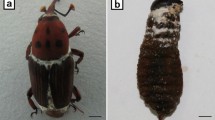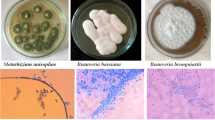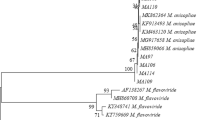Abstract
Mole crickets are significant pests of turf, vegetable and some tree seedlings worldwide, and it is costly to control them. In this study, we obtained 15 fungal isolates from Gryllotalpa gryllotalpa L. (Orthoptera: Gryllotalpidae) and compared the efficacy of these isolates against this pest with the aim of identifying their biocontrol potential. The fungal isolates were identified based on their morphological and molecular characteristics, using ITS, EF1-α, Bloc, RPB1, RPB2 and β-Tubulin gene sequencing. Consequently, the isolates were identified as Beauveria bassiana (Balsamo) Vuillemin (Gg-1), Clonostachys sp. (Gg-2, Gg-3, Gg-5, Gg-6, Gg-8 and Gg-13), Bionectria sp. (Gg-4), Metarhizium anisopliae (Metschnikoff) Sorokin (Gg-7, Gg-12 and Gg-14), Clonostachys rogersoniana (Schroers) (Gg-9 and Gg-15), Myriodontium sp. (Gg-10) and Myriodontium keratinophilum (Samson and Polon.) (Gg-11). These isolates caused mortalities ranging from 0 to 87 %, with the most virulent fungus being M. anisopliae Gg-12, which caused 87 % mortality within 15 days post inoculation using a conidial concentration of 1 × 107 conidia ml−1. Concentration–response test was conducted to determine the LC50 value of M. anisopliae Gg-12, and it was calculated as 1.069 × 106 conidia ml−1. As a result, M. anisopliae Gg-12 can be further investigated in terms of controlling mole crickets.




Similar content being viewed by others
References
Abbott WS (1925) A method of computing the effectiveness of an insecticide. J Econ Entomol 18:265–267
Altschul SF, Gish W, Miller W, Myers EW, Lipman DJ (1990) Basic local alignment search tool. J Mol Biol 215:403–410
Ansari MA, Butt TM (2012) Evaluation of entomopathogenic fungi and a nematode against the soil-dwelling stages of the crane fly Tipula paludosa. Pest Manag Sci 68:1337–1344
Ansari MA, Butt TM (2013) Influence of the application methods and doses on the susceptibility of black vine weevil larvae Otiorhynchus sulcatus to Metarhizium anisopliae in field-grown strawberries. Biocontrol 58:257–267
Ansari MA, Evans M, Butt TM (2009) Identification of pathogenic strains of entomopathogenic nematodes and fungi for wireworm control. Crop Prot 28:269–272
Benson DA, Karsch-Mizrachi I, Clark K, Lipman DJ, Ostell J, Sayers EW (2012) GenBank. Nucleic Acids Res 40(Database issue):D48–D53
Bidochka MJ, Kamp AM, Lavender TM, Dekoning J, De Croos JNA (2001) Habitat association in two genetic groups of the insect-pathogenic fungus Metarhizium anisopliae: Uncovering cryptic species? Appl Environ Microbiol 67:1335–1342
Bischoff JF, Rehner SA, Humber RA (2009) A multilocus phylogeny of the Metarhizium a nisopliae lineage. Mycologia 101:512–530
Er MK, Tunaz H, Gokce A (2007) Pathogenicity of entomopathogenic fungi to Thaumetopoea pityocampa (Schiff.) (Lepidoptera: Thaumatopoeidae) larvae in laboratory conditions. J Pest Sci 80:235–239
Ericsson JD, Kabaluk JT, Goettel MS, Myers JH (2007) Spinosad interacts synergistically with the insect pathogen Metarhizium anisopliae against the exotic wireworms Agriotes lineatus and Agriotes obscures (Coleoptera: Elateridae). J Econ Entomol 100:31–38
Felsenstein J (1985) Confidence limits on phylogenies: an approach using the bootstrap. Evol Int J Org Evol 39:783–791
Frank JH, Parkman JP (1999) Integrated pest management of pest mole crickets with emphasis on the southeastern USA. Int Pest Manag Rev 4:39–52
Goettel MS, Poprawski TJ, Vandenberg JD, Li Z, Roberts DW (1990) Safety to Nontarget Invertebrates of Fungal Biocontrol Agents. In: Laird M, Lacey LA, Davidson EW (eds) Safety of microbial insecticides. CRC Press, Boca Raton, pp 209–232
Goettel MS, Eilenberg J, Glare T (2005) Entomopathogenic fungi and their role in regulation of insect populations. In: Gilbert LI, Iatrou K, Gill SS (eds) Comprehensive molecular insect science. Elsevier, Amsterdam, pp 361–405
Hall TA (1990) BioEdit: a user-friendly biological sequence alignment editor and analysis program for Windows 95/98/NT. Nucl Acids Symp 41:95–98
Hertl PT, Brandenburg RL (1998) Evaluation of Beauveria bassiana spore applications for control of mole cricket nymphs in turf, 1997. Arthropod Manage Tests 23:323
Humber R (1997) Fungi: Identification. In: Lacey LA (ed) Manual of techniques in insect pathology. Academic Press, San Diego, pp 153–185
Khetan S (2001) Microbial pest control. Marcel Dekker, New York
Kocacevik S, Sevim A, Eroglu M, DemirbagZ Demir I (2015) Molecular characterization, virulence and horizontal transmission of Beauveria pseudobassiana from Dendroctonus micans (Kug.) (Coleoptera: Curculionidae). J Appl Entomol 139:381–389
Lacey LA, Frutos R, Kaya HK, Vail P (2001) Insect pathogens as biological control agents: Do they have a future? Biol Control 21:230–248
Liu YJ, Whelen S, Hall BD (1999) Phylogenetic relationships among ascomycetes: evidence from an RNA polymerase II subunit. Mol Biol Evol 16:1799–1808
Lomer CJ, Bateman RP, Johnson DL, Langewald J, Thomas M (2001) Biological control of locusts and grasshoppers. Ann Rev Entomol 46:667–702
Luz C, Tigano MS, Silva IG, Cordeiro CMT, Aljanabi SM (1998) Selection of Beauveria bassiana and Metarhizium anisopliae isolates to control Triatoma infestans. Mem Inst Oswaldo Cruz 93:839–846
Mascarin GM, Kobori NN, Quintela ED, Delalibera I (2013) The virulence of entomopathogenic fungi against Bemisia tabaci biotype B (Hemiptera: Aleyrodidae) and their conidial production using solid substrate fermentation. Biol Control 66:209–218
Meyling NV, Eilenberg J (2006) Occurrence and distribution of soil borne entomopathogenic fungi within a single organic agroecosystem. Agric Ecosyst Environ 113:336–341
Meyling NV, Eilenberg J (2007) Ecology of the entomopathogenic fungi Beauveria bassiana and Metarhizium anisopliae in temperate agroecosystems: Potential for conservation biological control. Biol Control 43:145–155
Muro MA, Meht S, Moore D (2003) The use of amplified fragmentlength polymorphism for molecular analysis of Beauveria bassiana isolates from Kenya and other countries, and their correlation with host and geographical origin. FEMS Microbiol Lett 229:249–257
O’Donnell K, Cigelnik E (1997) Two divergent intra genomic rDNA ITS2 types within a monophyletic lineage of the fungus Fusarium are non-orthologous. Mol Phylogenet Evol 7:103–116
Rehner SA, Buckley E (2005) A Beauveria phylogeny inferred from nuclear ITS and EF1-α sequences: evidence for cryptic diversification and links to Cordyceps teleomorphs. Mycologia 97:84–98
Rehner SA, Posada F, Buckley EP, Infante F, Castillo A, Vega FE (2006) Phylogenetic origins of African and Neotropical Beauveria bassiana pathogens of the coffee berry borer, Hypothenemus hampei. J Invertebr Pathol 93:11–21
Rehner SA, Minnis AM, Sung GH, Luangsa-ard JJ, Devotto L, Humber RA (2011) Phylogeny and systematics of the anamorphic, entomopathogenic genus Beauveria. Mycologia 103:1055–1073
Saitou N, Nei M (1987) The neighbor-joining method: a new method for reconstructing phylogenetic trees. Mol Biol Evol 4:406–425
Samson RA, Polonelli L (1978) Myriodontium keratinophilum Genet. spnov. Persoonia 9:505–509
Schroers HJ (2001) A monograph of Bionectria (Ascomycota, Hypocreales, Bionectriaceae) and its Clonostachys anamorphs. Stud Mycol 46:1–214
Sevim A, Demir I, Demirbag Z (2010a) Molecular characterization and virulence of Beauveria spp. from the pine processionary moth, Thaumetopoea pityocampa (Lepidoptera: Thaumetopoeidae). Mycopathologia 170:269–277
Sevim A, Demir I, Höfte M, Humber RH, Demirbag Z (2010b) Isolation and characterization of entomopathogenic fungi from hazelnut-growing region of Turkey. Biocontrol 55:279–297
Sevim A, Demir I, Tanyeli E, Demirbağ Z (2010c) Screening of entomopathogenic fungi against the European spruce barkbeetle, Dendroctonus micans (Coleoptera: Scolytidae). Biocontrol Sci Technol 20:3–11
Sevim A, Donzelli BGG, Wu D, Demirbag Z, Gibson DM, Turgeon BG (2012a) Hydrophobin genes of the entomopathogenic fungus, Metarhizium brunneum, are differentially expressed and corresponding mutants are decreased in virulence. Cur Genet 58:79–92
Sevim A, Höfte M, Demirbağ Z (2012b) Genetic variability of Beauveria bassiana and Metarhizium anisopliae var. anisopliae isolates obtained from the Eastern Black Sea Region of Turkey. Turk J Biol 36:255–265
Sevim A, Demir I, Sönmez E, Kocaçevik S, Demirbağ Z (2013) Evaluation of entomopathogenic fungi against the sycamore lace bug, Corythucha ciliate (Say) (Hemiptera: Tingidae). Turk J Agric For 37:595–603
Stiller JWB, Hall D (1997) The origin of red algae: implications for plastid evolution. Proc Natl Acad Sci 94:4520–4525
Sutton JC, Li DW, Peng G, Yu H, Zhang P, Valdebenito-Sanhueza RM (1997) Gliocladium roseum a versatile adversary of Botrytis cinereain crops. Plant Dis 81:316–328
Takatsuka J (2007) Characterization of Beauveria bassiana isolates from Japan using inter-simple-sequence-repeat-anchored-polymerase chain reaction (ISSR-PCR) amplification. Appl Entomol Zool 42:563–571
Talwar BH (2005) Isolation and characterization of entomopathogenic fungi and their effectiveness. Dissertation, Dharwad University of Agricultural Sciences
Tamura K, Stecher G, Peterson D, Filipski A, Kumar S (2013) MEGA6: Molecular evolutionary genetics analysis version 6.0. Mol Biol Evol 30:2725–2729
Tanyeli E, Sevim A, Demirbag Z, Eroglu M, Demir I (2010) Isolation and virulence of entomopathogenic fungi against the great spruce bark beetle, Dendroctonus micans (Kugelann) (Coleoptera: Scolytidae). Biocontrol Sci Technol 20:695–701
Ten Hoopen GM, George A, Martinez A, Stirrup T, Flood J, Krauss U (2010) Compatibility between Clonostachys isolates with a view to mixed inocula for biocontrol. Mycologia 102:1204–1215
The Ministry of Agriculture of Turkey (2008) The agricultural control technical recommendations. Basak Publisher, Ankara, pp 266–268
Thompson SR (2003) Biological control and behavioral studies of mole crickets (Orthoptera: Gryllotalpidae) with the entomopathogenic fungus, Beauveria bassiana (Balsamo) Vuillemin. Dissertation, Graduate Faculty of North Carolina State University
Thompson SR, Brandenburg RL (2005) Tunneling responses of mole crickets (Orthoptera: Gryllotalpidae) to the entomopathogenic fungus, Beauveria bassiana. Environ Entomol 34:140–147
Thompson SR, Brandenburg RL (2006) Effect of combining imidacloprid and diatomaceous earth with Beauveria bassiana on mole cricket (Orthoptera: Gryllotalpidae) mortality. J Econ Entomol 99:1948–1954
Thompson JD, Higgins DG, Gibson TJ (1994) CLUSTAL W: Improving the sensitivity of progressive multiple sequence alignment through sequence weighting, positions-specific gap penalties and weight matrix choice. Nucleic Acids Res 22:4673–4680
Thompson SR, Brandenburg RL, Roberson GT (2007) Entomopathogenic fungi detection and avoidance by mole crickets (Orthoptera: Gryllotalpidae). Environ Entomol 36:165–172
Toledo AV, Virla E, Humber RA, Paradell SL, López Lastra CC (2006) First record of Clonostachys rosea (Ascomycota: Hypocreales) as an entomopathogenic fungus of Oncometopia tucumana and Sonesimia grossa (Hemiptera: Cicadellidae) in Argentina. J Invertebr Pathol 92:7–10
White TJ, Bruns T, Lee S, Taylor J (1990) Amplification and direct sequencing of fungal ribosomal RNA genes for phylogenetics. In: Innis MA, Gelfand DH, Sninsky JJ, White TJ (eds) PCR protocols: a guide to methods and applications. Academic Press, San Diego, pp 315–322
Xia Y, Hertl PT, Brandenburg RL (2000) Surface and subsurface application of Beauveria bassiana for controlling mole crickets (Orthoptera: Gryllotalpidae) in golf courses. J Agric Urban Entomol 17:177–189
Zhang L, Yang J, Niu Q, Zhao X, Ye F, Liang L, Zhang KQ (2008) Investigation on the infection mechanism of the fungus Clonostachys rosea against nematodes using the green fluorescent protein. Appl Microbiol Biotechnol 78:983–990
Zimmermann G (2007a) Review on safety of the entomopathogenic fungi Beauveria bassiana and Beauveria brongniartii. Biocontrol Sci Technol 17:553–596
Zimmermann G (2007b) Review on safety of the entomopathogenic fungus Metarhizium anisopliae. Biocontrol Sci Technol 17:879–920
Acknowledgments
We would like to thank Dr. Richard Humber for his kind help with the morphological characterization of fungi, and to acknowledge with gratitude the input and insight of Tariq M. Butt for developing the discussion section and providing recommendations for this manuscript. Also, we would like to thank Özkan Görgülü for his advice on statistical analysis. This study was supported by Karadeniz Technical University, Scientific Research Projects Division (Project Number: KTU 8625).
Author information
Authors and Affiliations
Corresponding author
Rights and permissions
About this article
Cite this article
Sönmez, E., Sevim, A., Demirbağ, Z. et al. Isolation, characterization and virulence of entomopathogenic fungi from Gryllotalpa gryllotalpa (Orthoptera: Gryllotalpidae). Appl Entomol Zool 51, 213–223 (2016). https://doi.org/10.1007/s13355-015-0390-3
Received:
Accepted:
Published:
Issue Date:
DOI: https://doi.org/10.1007/s13355-015-0390-3




